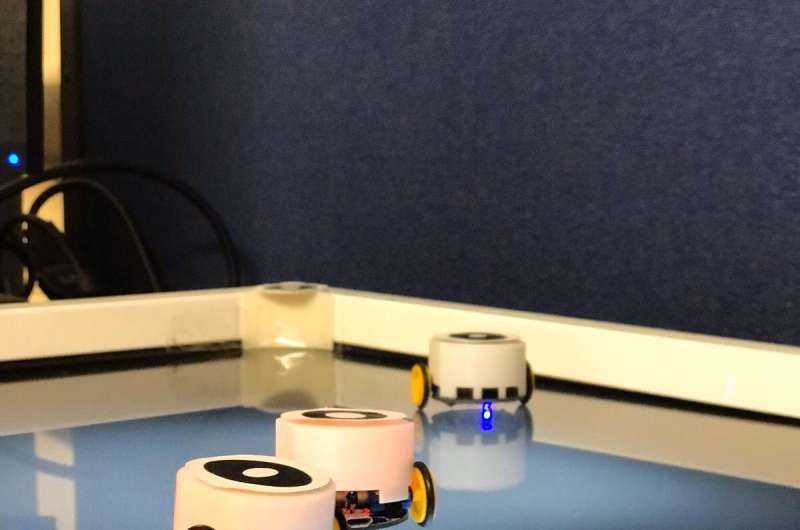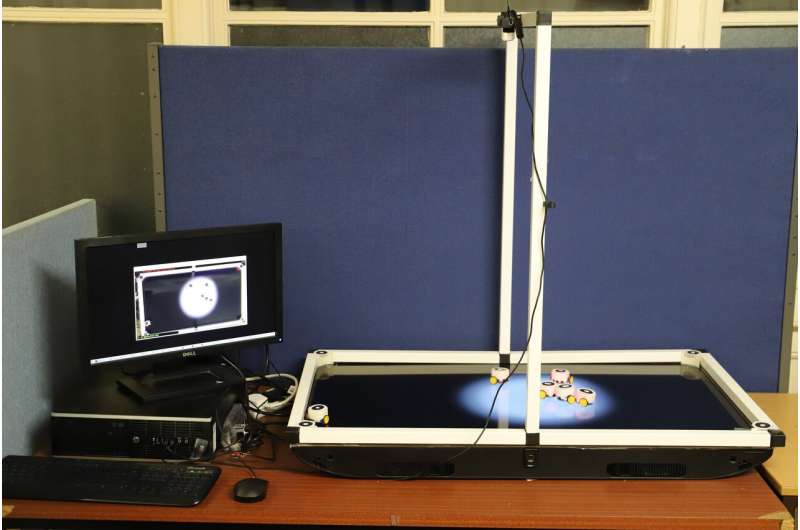July 9, 2020 feature
A system for swarm robotics applications inspired by pheromone communication in insects

Nature is one of the most valuable sources of inspiration for researchers developing new robots and computational techniques. Over the past few decades, technological advances have enabled the creation of increasingly sophisticated systems replicating naturally occurring processes and phenomena, such as animal behaviors and biological mechanisms.
A research team at the University of Manchester recently introduced a new technique for swarm robotics applications inspired by the use of pheromones among insect populations. Pheromones are chemical substances that animals and humans release into their surrounding environment, which can elicit a specific set of behaviors in other animals.
For instance, the release of pheromones can prompt mating behavior, alert other animals of a dangerous situation, delineate a territory, or signal the presence of food. In their paper, published in SAGE's Adaptive Behavior journal, the researchers tried to artificially replicate how social insects, such as ants, use pheromones, with the aim of achieving more effective communication among teams of robots.
"Our main idea was to develop a bio-inspired communication system based on social animals' pheromone communication systems," Farshad Arvin, one of the researchers who carried out the study, told TechXplore. "More specifically, we wanted to emulate how ants release pheromones and the behaviors that follow. We use the developed system in swarm robotics applications, and we are now investigating the possibility of testing it in real-world settings."
Past studies tried to create artificial pheromone systems using a variety of techniques, for instance, involving the use of alcohol, RFID tags and light as substitutes for the chemicals naturally released by animals. One of the most promising systems developed so far is COSΦ, a system that uses light to emulate pheromone release in humans and animals.

Arvin and his colleagues designed a system based on COSΦ, which also employs a model describing how pheromones spread across space and over time. This model draws inspiration from how a liquid or fluid flows in nature.
"To have a realistic model of the pheromone system, we had to model all the parameters of real pheromones, such as evaporation and diffusion, and consider the environmental impacts such as effects of wind," Arvin explained. "The model we proposed is a reliable and realistic model that can imitate pheromone communication among insects."
So far, the researchers evaluated their artificial pheromone system in a series of experiments in which a swarm of small mobile robots moved around and adapted to different environmental factors. Their results were highly promising, as their system enabled effective communication and prompted the desired group behaviors among members of the swarm.
"We developed a very realistic model of a pheromone system and systematically investigated the effects of various parameters in performance of the individual robots and the swarm," Arvin said. "In addition, our paper introduces a robust, open-source experimental setup that can be used to implement more complex behaviors typically observed in social insects."
This pheromone-inspired system could have many possible applications in the field of robotics. For instance, in the future, it could be used to enhance communication between individual robots in a team that are completing exploration missions in remote geographical areas, in complex environments, or under adverse weather conditions.
"We are currently expanding our system in three directions: (1) developing alternative communication systems for use in real-world scenarios, e.g. using light or sound for transferring small data packets within a swarm, (2) expanding the system with additional layers of pheromones, e.g. different colors and bandwidths, and (3) investigating an evolutionary swarm system where individuals improve their interactions with the pheromone over time," Arvin explained.
More information: Seongin Na et al. Bio-inspired artificial pheromone system for swarm robotics applications, Adaptive Behavior (2020). DOI: 10.1177/1059712320918936
© 2020 Science X Network

















